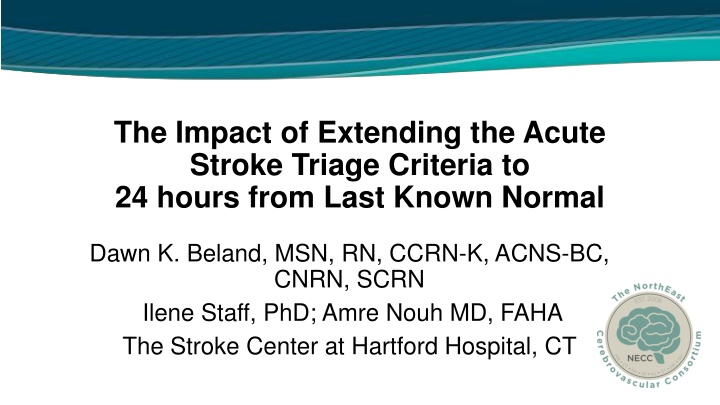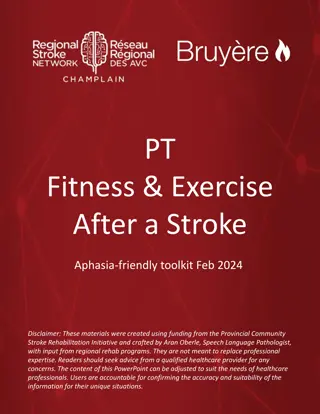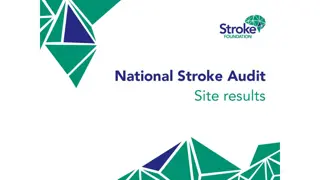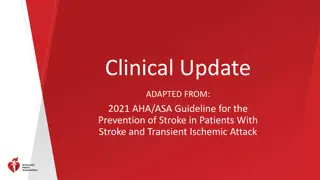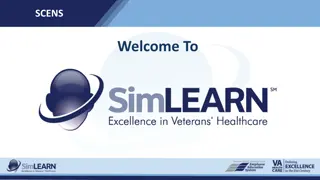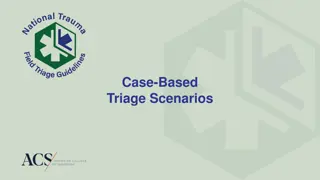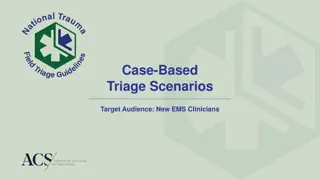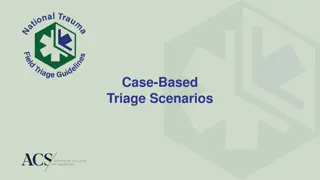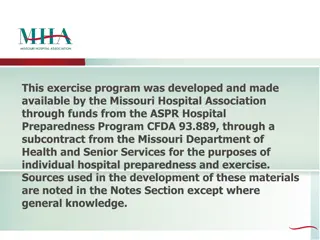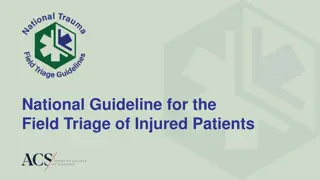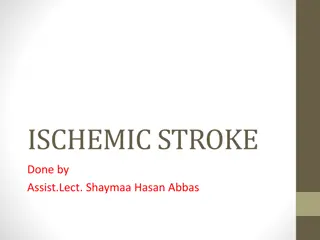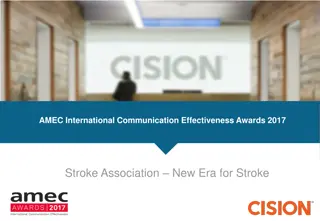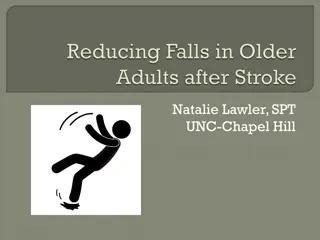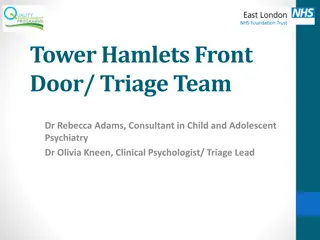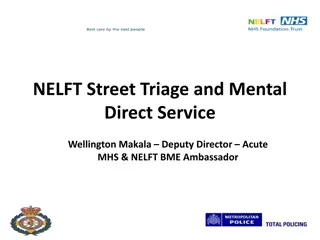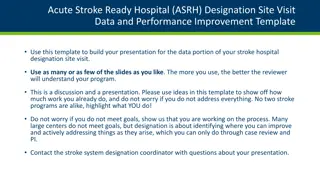Impact of Extending Acute Stroke Triage Criteria to 24 Hours
Landmark trials have extended the therapeutic time window for mechanical thrombectomy for acute ischemic stroke patients. This study evaluates the impact of implementing a protocol change to extend the time window at a comprehensive stroke center. Retrospective analysis compared stroke alerts and key time metrics before and after protocol implementation, showing improvements in timeliness for various interventions.
Download Presentation

Please find below an Image/Link to download the presentation.
The content on the website is provided AS IS for your information and personal use only. It may not be sold, licensed, or shared on other websites without obtaining consent from the author.If you encounter any issues during the download, it is possible that the publisher has removed the file from their server.
You are allowed to download the files provided on this website for personal or commercial use, subject to the condition that they are used lawfully. All files are the property of their respective owners.
The content on the website is provided AS IS for your information and personal use only. It may not be sold, licensed, or shared on other websites without obtaining consent from the author.
E N D
Presentation Transcript
The Impact of Extending the Acute Stroke Triage Criteria to 24 hours from Last Known Normal Dawn K. Beland, MSN, RN, CCRN-K, ACNS-BC, CNRN, SCRN Ilene Staff, PhD; Amre Nouh MD, FAHA The Stroke Center at Hartford Hospital, CT
Disclosures Disclosures No financial disclosures.
INTRODUCTION Landmark trials have extended the therapeutic time window for mechanical thrombectomy (EVT) from 6 to 24 hours for patients with acute ischemic stroke with large vessel occlusion as determined by CT perfusion 1,2 This would be expected to increase volume, but the effect of implementing protocol changes on ED Triage to address the extended time window in thrombectomy capable centers is not known3 We sought to evaluate this impact on our Large Academic affiliated Comprehensive stroke and Level 1 Trauma Center at Hartford Hospital 1.Albers GW, et al, for the DEFUSE 3 Investigators*. Thrombectomy for Stroke at 6 to 16 Hours with Selection by Perfusion Imaging. N Engl J Med. 2018;378:708-718. 2.Nogueira RG, et al, for the DAWN Trial Investigators*. Thrombectomy 6 to 24 Hours After Stroke with a Mismatch Between Deficit and Infarct. N Engl J Med. 2018;378:11-21. 3.Alberts, Mark J., Martin D. Ollenschleger, and Amre Nouh. DAWN of a new Era for stroke treatment: implications of the DAWN study for acute stroke care and stroke systems of care. Circulation 137.17 (2018): 1767-1769.
MATERIALS & METHODS A retrospective Quality Improvement project compared all patients presenting with stroke like symptoms triaged prior to implementation of the extended time protocol (March-August 2017 n = 612) to patients after the extended protocol was implemented (October 2017-March 2018 n = 882) Metrics to evaluate triage impact between both groups included: Total number of stroke alerts Time for: Door to CT Door to decision Decision to drug administration Door to needle for IV-thrombolytic Door to groin puncture for EVTs
RESULTS Group 1 612 Group 2 882 Delta 44.1% p p # ST calls Mean/ median Variance Total treated 93 102 9.7% - IV - IV transfers - IV/EVT - IV tx/EVT - EVT 35 31 5 6 16 25 35 7 9 26 .045a -Total EVT (27) (42) 55.5% Door to CT for Act calls N Mean (SD) Median (IQR) Door to Drug N Mean (SD) Median (IQR) Door to Decision N Mean (SD) Median (IQR) Decision to Admin N Mean (SD) Median (IQR) Door to puncture N Mean (SD) Median (IQR) 215 339 26.5 (30.3) 19 (8,36) .135d 19.6 (21.2) 12 (4,26) 37.3% 58.3% <0.001b 40 54.2 (23.8) 45 (36.3,68.0) 32 .126d 65.3 (38.4) 56 (41.3, 78.0) 20.5% 24.4% .267b 40 32 .101c .035d 38.9 (20.7) 33 (24.3, 46.8) 51.6 (38.7) 37.5 (28,59.3) 32.6% 13.6% 40 32 .409d 15.4 (16.5) 11 (6,19) 13.8 (8.8) 11.5 (6,21) -10.3% 4.5% .977b a Chi-square test of proportion of EVT compared to other treated b Wilcoxon Ranked Sum test (normality assumption not met) c T-test for independent groups (normality assumption met) d Levene test for equality of variance 27 42 .111c .015d 124.6 (38.9) 123 (92,145) 149.8 (88.9) 129.5 (94.8,153) 20.2% 5.2%
DISCUSSION Although the number of ED stroke alerts increased by 44.1%, this translated into only a 9.7% increase in total acute ischemic stroke treatments (IV tPA, tPA transfers, EVTs or a combination) despite a 55.5% increase in EVT alone. Although increases in mean time (mins) were observed for most parameters, only Door to CT times were statistically significant Variability in patient processes in the ED secondary to increased volume contributed mostly to delays, in contrast to volume increase alone. Variance was higher in Group 2 for 4 of 5 metrics and statistically significant for door to decision and door to puncture
CONCLUSION Although extended time windows have increased the number of EVTs by 55.5%,delays in almost all care metrics were observed. The increase in stroke alerts with more imaging upon presentation leading to process variability is a significant factor. Other factors including process change education and additional perfusion imaging required contribute to delay. Review of our process through a Lean Management Kaizen (QI initiative) in June 2018 has produced additional resources and novel approaches to handle increases in volume as needed to prevent delays in the ED.
NEXT STEPS The ED/Stroke Kaizen broke down the steps of door to puncture and identified new approaches to streamline processes. Triage to CT Approved to install second CT scan in ED, permanent scale in hallway CT to tPA administration Instituted a post-CT Pause , and stroke resident phone tPA administration to EVT decision Streamline communication between team, Code Neurointervention page Decision to EVT to puncture Create standard work/equipment for IR room/case set-up, expand off- shift competencies to ready room
